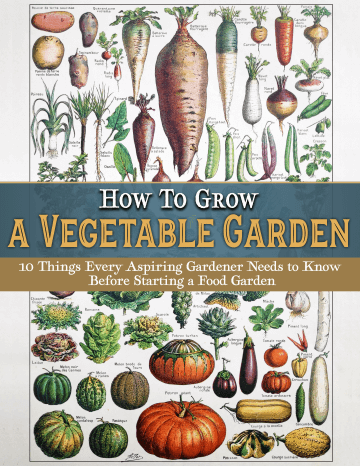
It’s understandable that most people don’t think about how to cover a garden in the winter. After all, by that time of the year, it’s usually just dirt, and what’s the point of covering that?
Of course, it’s not quite that simple. There are several reasons to cover your garden over the winter, especially if you still have some cool-weather crops going. And you have choices about how to cover a garden, from mulch to tarps to cardboard. But first, some clean-up is in order.
Discover 10 top tips for growing, harvesting, and enjoying fruits, vegetables, herbs and more from your home garden—when you access the FREEBIE How to Grow a Vegetable Garden, right now!

Cleaning up and getting ready for winter
Before you can cover your garden, you’ll want to do some tidying up. Pull out any remaining weeds and diseased plants. If possible, burn them. If you can’t do that, tie them in a garbage bag and discard them. You don’t want to risk weed seeds or plant diseases making it through the composting process alive and ready to damage your next garden season.
With any remaining plant stems, you can either toss them into your compost pile or cut them down and leave them in place where they will decompose and add nutrients to the soil. This is also an excellent time to make any repairs to garden structures like raised beds or trellises.
How to cover a garden for a successful crop next season
Why do we need to determine how to cover a garden the best possible way? Even in the winter, when it doesn’t look like anything is going on in the garden, there are still tiny microbes down in the soil working away. They may not be working as quickly as they are in mid-summer, but they’re still there. Ground cover can help regulate the temperature and keep those microbes just a little warmer.
Additionally, winter winds can blow your rich topsoil away. Covering your garden helps prevent this, keeping all those nutrients in your soil. Along with these benefits is one that every gardener loves: fewer weeds.
Covering your garden over the winter can help kill off any remaining weeds as they don’t get the sun they need to regrow in the spring. That’s the why. Now let’s get into how to cover a garden, because you have several options.
If you’re in a slightly warmer climate or you’re hoping to keep some of those winter greens going as long as possible, you can look into a cold frame or row covers. These act like mini-greenhouses, keeping temperatures up and protecting plants and the soil from harsh and dry winter winds. Row covers are relatively inexpensive and user-friendly.
Outside of that, you have four other options: planting ground cover crops, adding compost or mulch, or using tarps or cardboard. The primary benefit to tarps and cardboard is their ability to kill weeds. They completely block the sunlight, so those weed seeds don’t get any of the light they need to sprout and grow. Cardboard will eventually break down into compost. You can save and reuse tarps or landscape fabric. If you have a dark color, these options also increase the soil temperature, letting you start your garden a bit earlier in the spring.
As for mulch and compost, the main difference between them is that compost is already broken down and can start enriching the soil right away. On the other hand, mulch needs time to decompose before the soil gets any nutritional benefits.
Both mulch and compost act much the same, otherwise. They can help prevent weed growth in the spring. In addition, they help regulate soil temperature. The trick to getting these benefits is to add a two or three-inch layer of compost or mulch to your garden.
Lastly, the roots of cover crops, such as winter wheat, will help keep soil healthy and in place over the winter. And when spring rolls around, you can cut it down and incorporate it into the soil for an additional boost of nutrients as it decomposes over the next several weeks.
Do you cover your garden in the winter? Which method do you find works best?
Discover 10 top tips for growing, harvesting, and enjoying fruits, vegetables, herbs and more from your home garden—when you access the FREEBIE How to Grow a Vegetable Garden, right now!




